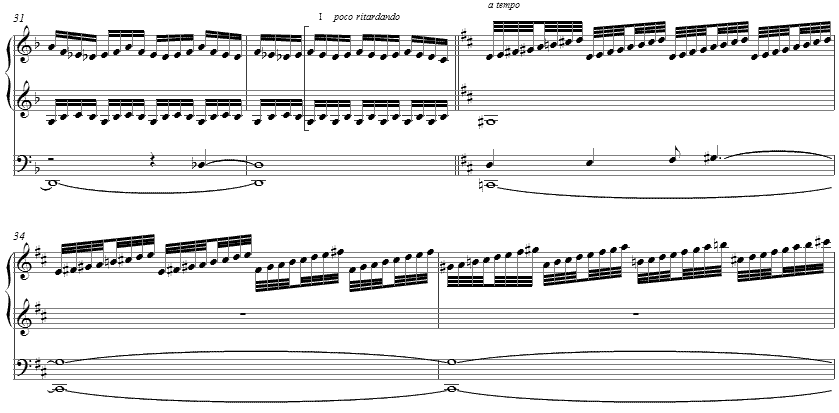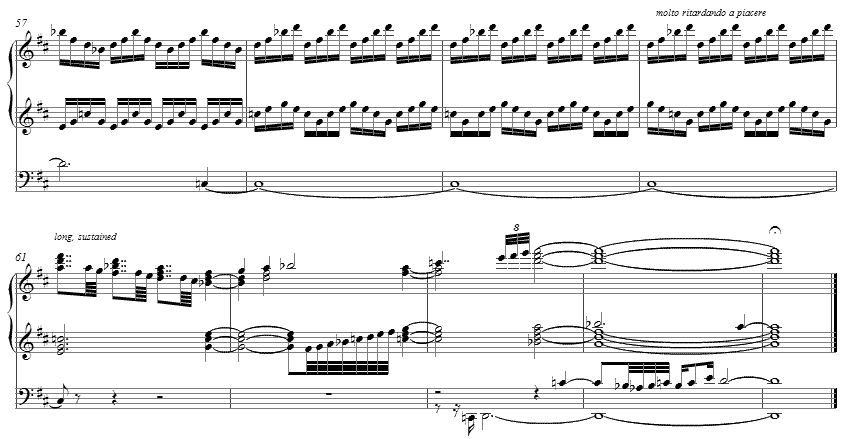Music and Texts of GARY BACHLUND
Vocal Music | Piano | Organ | Chamber Music | Orchestral | Articles and Commentary | Poems and Stories | Miscellany | FAQs
Cherubim and Seraphim Do Cry - (2002)
for organ
for Timothy Howard
The Akkadian [ 1 ] root of the word "Cherubim" seems best to have indicated "grace." This virtuosic piece takes its title from the exact phrase in the Te Deum, "Tibi Cherubim et Seraphim incessabili voce proclamant...." The theme of these ranks of angels is, of course, biblical. The first mention in the Hebrew scriptures of the Cherubim -- whose root we know as "cherub," the connotation being like a child -- comes from the fall from grace of Adam, as he is driven out of Eden. That vision is anything but childlike.
"So he drove out the man; and he placed at the east of the garden of Eden Cherubim, and a flaming sword which turned every way, to keep the way of the tree of life." [Genesis 3:24]
This angelology is continued as Cherubim were physically represented as guarding the Ark of the Covenant, and also as surrounding the heavenly place of God, as in following rhetorical images:
And Hezekiah prayed before the Lord, and said, O Lord God of Israel, which dwells between the Cherubim, you are the God, even you alone, of all the kingdoms of the earth; you have made heaven and earth. [II Kings, 19:15]
Give ear, O Shepherd of Israel, you that leads Joseph like a flock; you that dwells between the cherubim, shine forth. [Psalms 80:1]
Seraphim [ 2 ], the other type of the great angels, carry an image of expiation. Images from Isaiah see them as one sort of heavenly beings surrounding the throne of God, each represented as having three pairs of wings.
Then flew one of the seraphim to me having a live coal in his hand which he had taken with the tongs from off the altar: and he laid it upon my mouth, and said, Lo, this has touched your lips; and your iniquity is taken away, and your sin purged. [Isaiah 6:6-7]
One finds images of strength of force, glory and grandeur, wrapped up also in images of the ritual purging of sin. These kinds of images were summed up in the phrase which became a part of the Te Deum of the Latin rite, and thence found its way into Protestant liturgy as well. Yet the images are also Judaic, of course, stemming from the original sources. The pre-Judaic sources indicate that this common set of images -- which encompasses the child-like to the winged guardian angels of heaven -- speaks to our subconscious through many cultures of the immediate closeness and yet vast distance of the God-head.
The work is meant as a tour de force for the performer, and is therefore notated "breathless" to indicate a tempo at the limits of the performer's technical and virtuosic skills.
As the center and before a reprise of the opening gesture, a toccata-like ascending set of scales heightens the tension while breaking the rhythmic forward motion.
The final chords are massive and resolve the polytonal elements of the work, while employing the full resources of the organ.
The score is available as a free PDF download, though any major commercial performance or recording of the work is prohibited without prior arrangement with the composer. Click on the graphic below for this organ score.
Timothy Howard
Dr. Timothy Howard serves as staff organist for Pasadena Presbyterian Church, after having served as Assistant Organist at All Saints Church, Pasadena, where he debuted the Requiem for the Victims of AIDS (1991) as well as Jacob's Ladder, a chamber work for harp and organ and The Jerusalem Windows (1993). He is himself a composer as well as professor of music at California State University at Northridge.
NOTES
[ 1 ] Akkadian is an extinct Semitic language of the Mesopotamian region, constituting the eastern branch of the Semitic language subfamily.
[ 2 ] The Hebrew root suggests "burning," consistent also with the image of the "flaming sword" wielded in the story of the expulsion from Eden.



